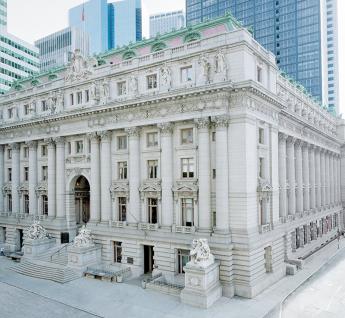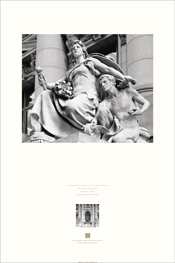Location: 1 Bowling Green, New York, NY 10004
History
The U.S. Customs Service, established by the First Congress in 1789, is the oldest federal agency. The Customs Service assesses and collects duties and taxes on imported goods, controls carriers of imports and exports, and combats smuggling and revenue fraud.
The monumental Alexander Hamilton U.S. Custom House sits prominently on Bowling Green at Manhattan’s tip. Bowling Green, the island’s first parade ground and park, was the site of the city’s first Custom House which burned down in 1814. The customs service moved several times, but by 1888 a new, larger home was needed for its activities in the prospering port of New York. The government purchased the Bowling Green site in 1892.
The Tarsney Act of 1893 played an important role in the design of the Alexander Hamilton U.S. Custom House. It authorized the secretary of the treasury to use private architects, selected through architectural competitions, to design federal buildings. As a process, it manifested the growing demand for greater architectural standards for public buildings and opened the way for added appropriations to maintain those standards. In 1899 Supervising Architect of the Treasury James Knox Taylor (1857-1929) invited twenty firms to vie for the U.S. Custom House commission. Cass Gilbert’s elaborate Beaux Arts design was selected.
Cass Gilbert (1859-1934) was trained at the Massachusetts Institute of Technology and worked at the renowned New York firm of McKim, Mead, and White. In 1887 he set up practice in St. Paul, Minnesota with James Knox Taylor. After moving his office to New York City, Gilbert designed such notable buildings as New York’s Woolworth Building (1913) and Washington, DC’s U.S. Supreme Court (1929-1935). His U.S. Custom House design reflects the planning and aesthetic ideals of the City Beautiful movement, which promoted civic patriotism, urban economics and beauty.
The building was listed in the National Register of Historic Places in 1972 and was designated a National Historic Landmark in 1976. In 1979 New York City’s Landmarks Preservation Commission made the exterior and public interior spaces a city landmark. In 1994, the George Gustav Heye Center of the National Museum of the American Indian opened in the building. The U.S. Bankruptcy Courts and U.S. Department of Transportation offices are also in the building.
Architecture
The striking Beaux Arts U.S. Custom House is a steel-framed, seven-story structure on the south side of Bowling Green at the foot of Broadway. The building was intentionally designed to face the historically significant Bowling Green rather than the harbor, reversing the usual orientation of a custom house.
The building’s rusticated first story supports three stories of single and paired full-height, engaged Corinthian columns. The fifth story is encompassed within the frieze of the massive entablature. Above the entablature is the sixth story. The seventh story is within the mansard roof.
A grand stair, facing Bowling Green, provides a stately approach to the building. The cavernous entry is set within a barrel vault, enhanced with blue, gold, rose, and green mosaics and Levanto marble columns. Bronze gates secure the paneled bronze doors leading into the Great Hall.
Enclosed pediments with molded brackets cap the windows of the piano nobile. Typical of the Beaux Arts style, the openings on the third and fourth stories are decorated with granite surrounds less detailed than the more prominent lower stories. Small rectangular openings pierce the frieze, providing daylight to the fifth story. Copper cresting outlines the red slate roof and dormer windows.
The most significant decorative features on the exterior are Daniel Chester French’s (1850-1931) monumental sculptures representing international commerce. Four female figures of limestone sit on large entrance pedestals and represent America, Asia, Europe, and Africa. Above the columns on the main facade are twelve marble statues, representing seafaring nations. Above the windows are sculpted heads depicting the “eight races” of mankind.
The interior of the Alexander Hamilton U.S. Custom House is an exquisite example of Beaux Arts planning combining clarity, symmetry, and ceremonial spaces. The building presents a square plan with a central rotunda and surrounding corridors. The ceremonial, two-story Great Hall on the piano nobile is ornately detailed with marble finishes in a variety of textures and colors quarried in the United States, Switzerland, and Italy. At both ends of the Great Hall are curved staircases finished with decorative plaster, bronze railings, and marble treads and risers.
Other ceremonial spaces include the Collector’s Suite (with oak panels designed by Tiffany Studios), Cashier’s Office, and Naval Officer’s Rooms. Nautical motifs, such as shells, snails, dolphins, tridents, and ships’ wheels and prows decorate these spaces. The three-story oval rotunda measures 135 by 85 feet. The tile and plaster-domed ceiling of the rotunda is one of the masterpieces of Spanish engineer Raphael Guastavino (1842-1908). Between the skylight and the dome’s entablature are murals by New York artist Reginald Marsh (1898-1954) depicting ships entering New York Harbor.
During the last two decades of the twentieth century, the Alexander Hamilton U.S. Custom House has under-gone meticulous restoration. Two feasibility studies, creation of the Custom House Institute in 1973, and passage of the Public Buildings Cooperative Use Act of 1976, which encourages the federal government to reuse its historically and architecturally significant buildings, spurred the U.S. General Services Administration to restore the building. In 1979 Congress authorized $26,500,000 for the building’s restoration and rehabilitation. The project began in 1983 and continued until 1994. Work included cleaning the building’s facade and conserving interior murals, decorative paintings, woodwork, metalwork, and marble. Space was adapted for use as Federal courtrooms, ancillary offices, meeting rooms, and an auditorium.
In 1994 following the completion of restoration work led by Ehrenkrantz, Eckstut and Kuhn Architects, the Smithsonian’s National Museum of the American Indian moved into the building. In 2001 additional repairs were completed and the rotunda was restored.
Significant Events
- 1899: Cass Gilbert wins design competition for a new U.S. Custom House in New York.
- 1900-1907: The U.S. Custom House is constructed.
- 1971: The Customs Service vacates the building and moves to the World Trade Center.
- 1972: The U.S. Custom House is listed in the National Register of Historic Places.
- 1976: The U.S. Custom House is designated a National Historic Landmark.
- 1978: The U.S. General Services Administration holds a competition for proposals for the restoration and rehabilitation of the building.
- 1979: The Landmarks Preservation Commission of New York City designates the exterior and all public interiors of the building as a city Landmark.
- 1994: After a multi-year, award-winning restoration and rehabilitation, The Smithsonian’s National Museum of the American Indian moves in.
- 2007: Building celebrates centennial.
Building Facts
- Architectural Style: Beaux Arts
- Architect: Cass Gilbert
- Construction Dates: 1900-1907
- Landmark Status: National Historic Landmark
- GSA Building Number: NY0131ZZ
- Primary Materials: Granite Exterior Marble interior
- Prominent Features: Four Continents sculptures by Daniel Chester French; Rotunda with murals by Reginald Marsh Collector’s Suite with oak paneling by Tiffany Studios
Poster downloads
Download the poster 1 [PDF - 3 MB]
Download the poster 2 [PDF - 3 MB]
Download the poster 3 [PDF - 2 MB]
Download the poster 4 [PDF - 366 KB]

 U.S. General Services Administration
U.S. General Services Administration

